Analysis of Performance Management in Steel Company: A Report
VerifiedAdded on 2020/01/28
|9
|2254
|58
Report
AI Summary
This report examines the performance management system within Steel Co., addressing challenges in managing the workforce and identifying areas for improvement. It explores the structuring of individual performance targets, emphasizing the importance of the SMART approach and employee-manager interaction. The report highlights the role of performance management in enhancing employee development and communication, advocating for a shift from an autocratic leadership style to one that encourages employee engagement and participation. Furthermore, it underscores the necessity of integrating the performance management system with other HR processes, such as talent and learning management, to leverage technology and address employee needs effectively. The report also discusses the effectiveness of linking performance to financial rewards, suggesting a balanced approach that considers both monetary and non-monetary incentives to motivate employees and drive organizational success. The conclusion emphasizes the importance of a robust performance management system in fostering employee integration, improving communication, and achieving organizational goals.
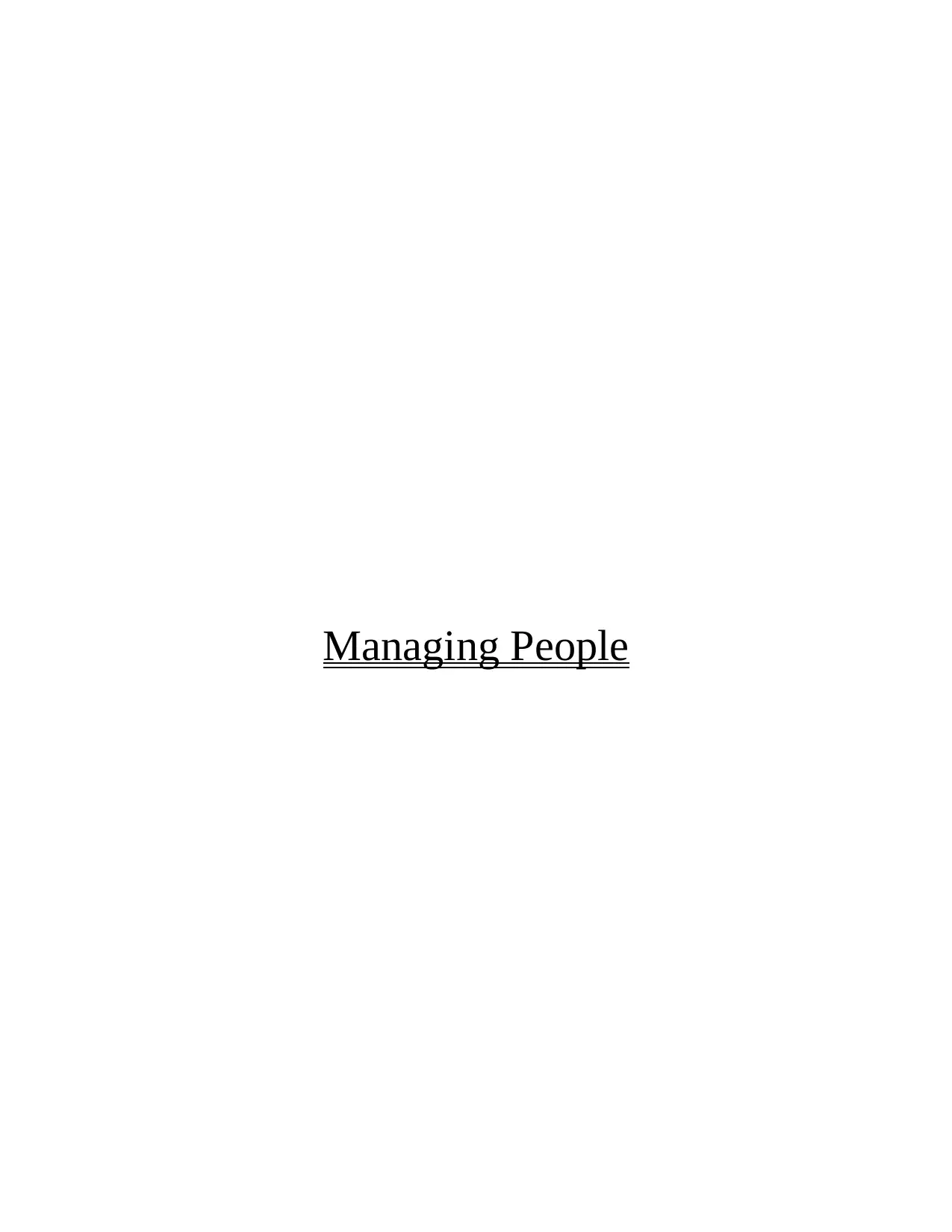
Managing People
Paraphrase This Document
Need a fresh take? Get an instant paraphrase of this document with our AI Paraphraser
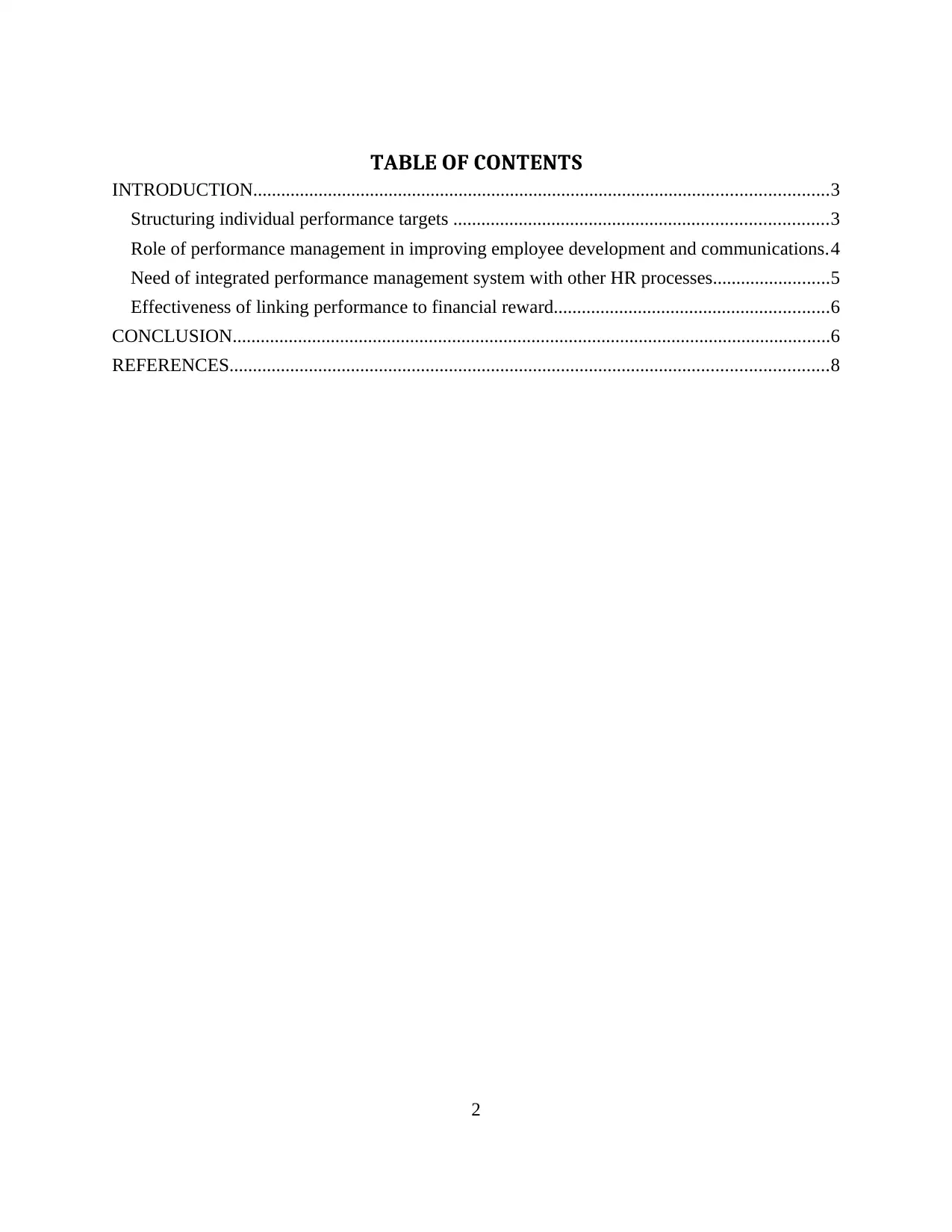
TABLE OF CONTENTS
INTRODUCTION...........................................................................................................................3
Structuring individual performance targets ................................................................................3
Role of performance management in improving employee development and communications.4
Need of integrated performance management system with other HR processes.........................5
Effectiveness of linking performance to financial reward...........................................................6
CONCLUSION................................................................................................................................6
REFERENCES................................................................................................................................8
2
INTRODUCTION...........................................................................................................................3
Structuring individual performance targets ................................................................................3
Role of performance management in improving employee development and communications.4
Need of integrated performance management system with other HR processes.........................5
Effectiveness of linking performance to financial reward...........................................................6
CONCLUSION................................................................................................................................6
REFERENCES................................................................................................................................8
2
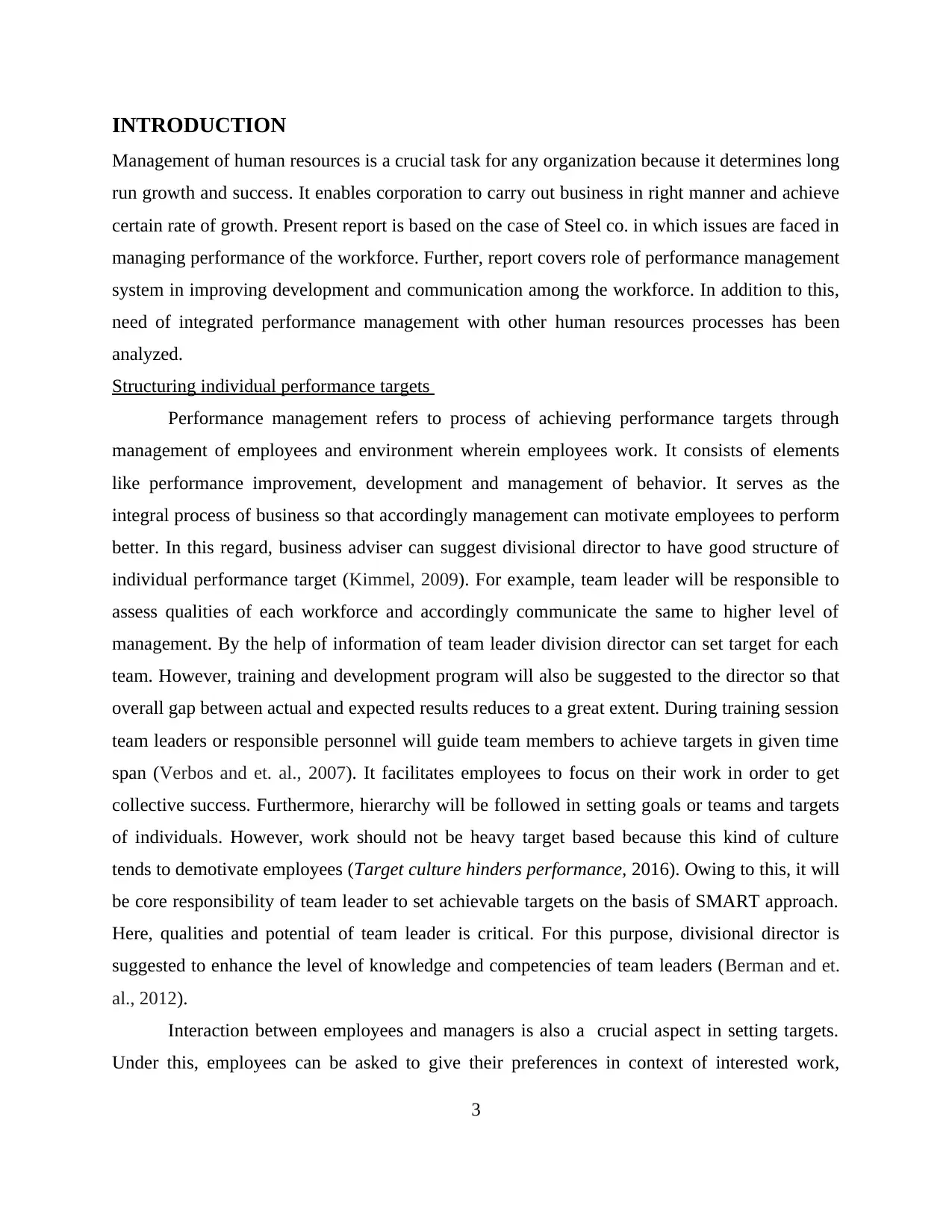
INTRODUCTION
Management of human resources is a crucial task for any organization because it determines long
run growth and success. It enables corporation to carry out business in right manner and achieve
certain rate of growth. Present report is based on the case of Steel co. in which issues are faced in
managing performance of the workforce. Further, report covers role of performance management
system in improving development and communication among the workforce. In addition to this,
need of integrated performance management with other human resources processes has been
analyzed.
Structuring individual performance targets
Performance management refers to process of achieving performance targets through
management of employees and environment wherein employees work. It consists of elements
like performance improvement, development and management of behavior. It serves as the
integral process of business so that accordingly management can motivate employees to perform
better. In this regard, business adviser can suggest divisional director to have good structure of
individual performance target (Kimmel, 2009). For example, team leader will be responsible to
assess qualities of each workforce and accordingly communicate the same to higher level of
management. By the help of information of team leader division director can set target for each
team. However, training and development program will also be suggested to the director so that
overall gap between actual and expected results reduces to a great extent. During training session
team leaders or responsible personnel will guide team members to achieve targets in given time
span (Verbos and et. al., 2007). It facilitates employees to focus on their work in order to get
collective success. Furthermore, hierarchy will be followed in setting goals or teams and targets
of individuals. However, work should not be heavy target based because this kind of culture
tends to demotivate employees (Target culture hinders performance, 2016). Owing to this, it will
be core responsibility of team leader to set achievable targets on the basis of SMART approach.
Here, qualities and potential of team leader is critical. For this purpose, divisional director is
suggested to enhance the level of knowledge and competencies of team leaders (Berman and et.
al., 2012).
Interaction between employees and managers is also a crucial aspect in setting targets.
Under this, employees can be asked to give their preferences in context of interested work,
3
Management of human resources is a crucial task for any organization because it determines long
run growth and success. It enables corporation to carry out business in right manner and achieve
certain rate of growth. Present report is based on the case of Steel co. in which issues are faced in
managing performance of the workforce. Further, report covers role of performance management
system in improving development and communication among the workforce. In addition to this,
need of integrated performance management with other human resources processes has been
analyzed.
Structuring individual performance targets
Performance management refers to process of achieving performance targets through
management of employees and environment wherein employees work. It consists of elements
like performance improvement, development and management of behavior. It serves as the
integral process of business so that accordingly management can motivate employees to perform
better. In this regard, business adviser can suggest divisional director to have good structure of
individual performance target (Kimmel, 2009). For example, team leader will be responsible to
assess qualities of each workforce and accordingly communicate the same to higher level of
management. By the help of information of team leader division director can set target for each
team. However, training and development program will also be suggested to the director so that
overall gap between actual and expected results reduces to a great extent. During training session
team leaders or responsible personnel will guide team members to achieve targets in given time
span (Verbos and et. al., 2007). It facilitates employees to focus on their work in order to get
collective success. Furthermore, hierarchy will be followed in setting goals or teams and targets
of individuals. However, work should not be heavy target based because this kind of culture
tends to demotivate employees (Target culture hinders performance, 2016). Owing to this, it will
be core responsibility of team leader to set achievable targets on the basis of SMART approach.
Here, qualities and potential of team leader is critical. For this purpose, divisional director is
suggested to enhance the level of knowledge and competencies of team leaders (Berman and et.
al., 2012).
Interaction between employees and managers is also a crucial aspect in setting targets.
Under this, employees can be asked to give their preferences in context of interested work,
3
⊘ This is a preview!⊘
Do you want full access?
Subscribe today to unlock all pages.

Trusted by 1+ million students worldwide
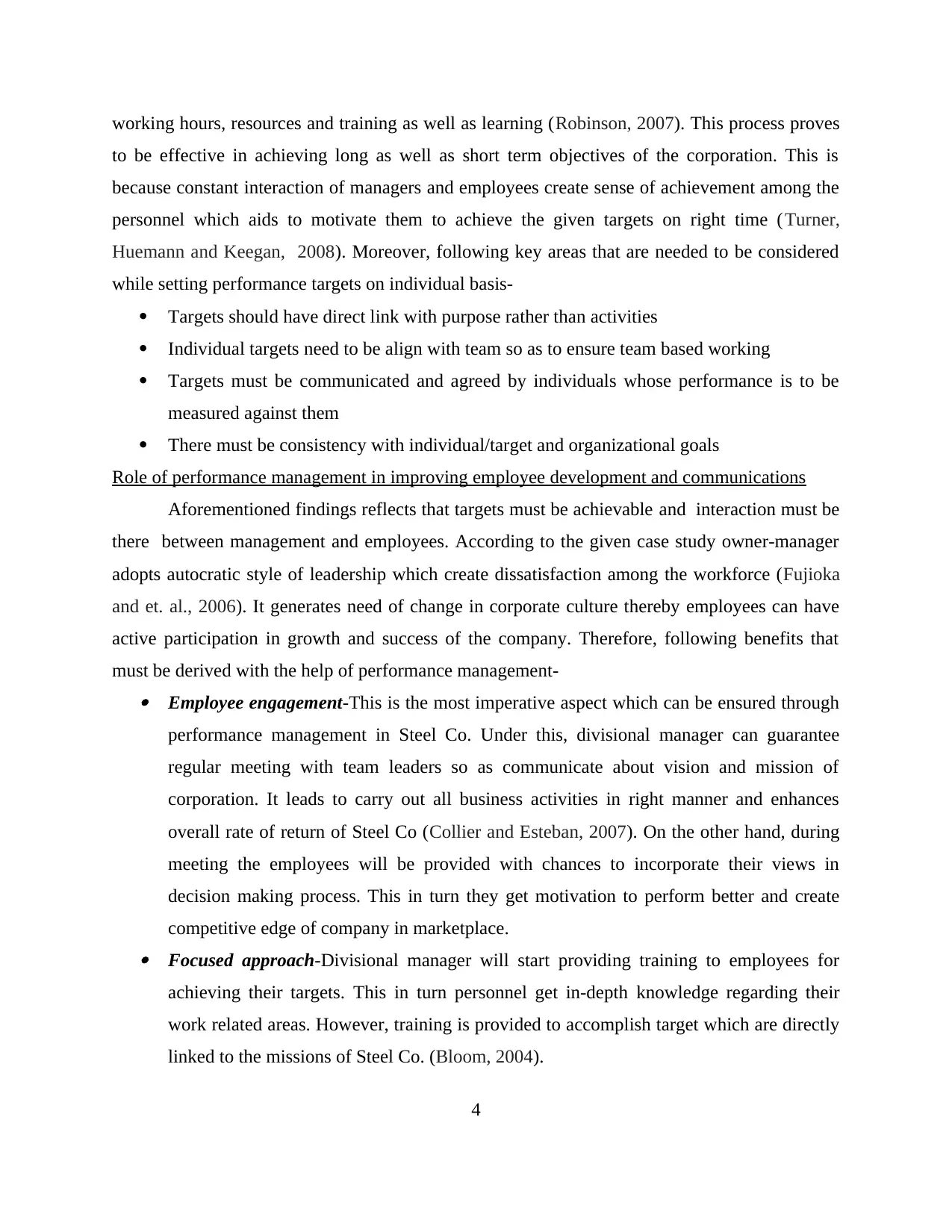
working hours, resources and training as well as learning (Robinson, 2007). This process proves
to be effective in achieving long as well as short term objectives of the corporation. This is
because constant interaction of managers and employees create sense of achievement among the
personnel which aids to motivate them to achieve the given targets on right time (Turner,
Huemann and Keegan, 2008). Moreover, following key areas that are needed to be considered
while setting performance targets on individual basis-
Targets should have direct link with purpose rather than activities
Individual targets need to be align with team so as to ensure team based working
Targets must be communicated and agreed by individuals whose performance is to be
measured against them
There must be consistency with individual/target and organizational goals
Role of performance management in improving employee development and communications
Aforementioned findings reflects that targets must be achievable and interaction must be
there between management and employees. According to the given case study owner-manager
adopts autocratic style of leadership which create dissatisfaction among the workforce (Fujioka
and et. al., 2006). It generates need of change in corporate culture thereby employees can have
active participation in growth and success of the company. Therefore, following benefits that
must be derived with the help of performance management- Employee engagement-This is the most imperative aspect which can be ensured through
performance management in Steel Co. Under this, divisional manager can guarantee
regular meeting with team leaders so as communicate about vision and mission of
corporation. It leads to carry out all business activities in right manner and enhances
overall rate of return of Steel Co (Collier and Esteban, 2007). On the other hand, during
meeting the employees will be provided with chances to incorporate their views in
decision making process. This in turn they get motivation to perform better and create
competitive edge of company in marketplace. Focused approach-Divisional manager will start providing training to employees for
achieving their targets. This in turn personnel get in-depth knowledge regarding their
work related areas. However, training is provided to accomplish target which are directly
linked to the missions of Steel Co. (Bloom, 2004).
4
to be effective in achieving long as well as short term objectives of the corporation. This is
because constant interaction of managers and employees create sense of achievement among the
personnel which aids to motivate them to achieve the given targets on right time (Turner,
Huemann and Keegan, 2008). Moreover, following key areas that are needed to be considered
while setting performance targets on individual basis-
Targets should have direct link with purpose rather than activities
Individual targets need to be align with team so as to ensure team based working
Targets must be communicated and agreed by individuals whose performance is to be
measured against them
There must be consistency with individual/target and organizational goals
Role of performance management in improving employee development and communications
Aforementioned findings reflects that targets must be achievable and interaction must be
there between management and employees. According to the given case study owner-manager
adopts autocratic style of leadership which create dissatisfaction among the workforce (Fujioka
and et. al., 2006). It generates need of change in corporate culture thereby employees can have
active participation in growth and success of the company. Therefore, following benefits that
must be derived with the help of performance management- Employee engagement-This is the most imperative aspect which can be ensured through
performance management in Steel Co. Under this, divisional manager can guarantee
regular meeting with team leaders so as communicate about vision and mission of
corporation. It leads to carry out all business activities in right manner and enhances
overall rate of return of Steel Co (Collier and Esteban, 2007). On the other hand, during
meeting the employees will be provided with chances to incorporate their views in
decision making process. This in turn they get motivation to perform better and create
competitive edge of company in marketplace. Focused approach-Divisional manager will start providing training to employees for
achieving their targets. This in turn personnel get in-depth knowledge regarding their
work related areas. However, training is provided to accomplish target which are directly
linked to the missions of Steel Co. (Bloom, 2004).
4
Paraphrase This Document
Need a fresh take? Get an instant paraphrase of this document with our AI Paraphraser
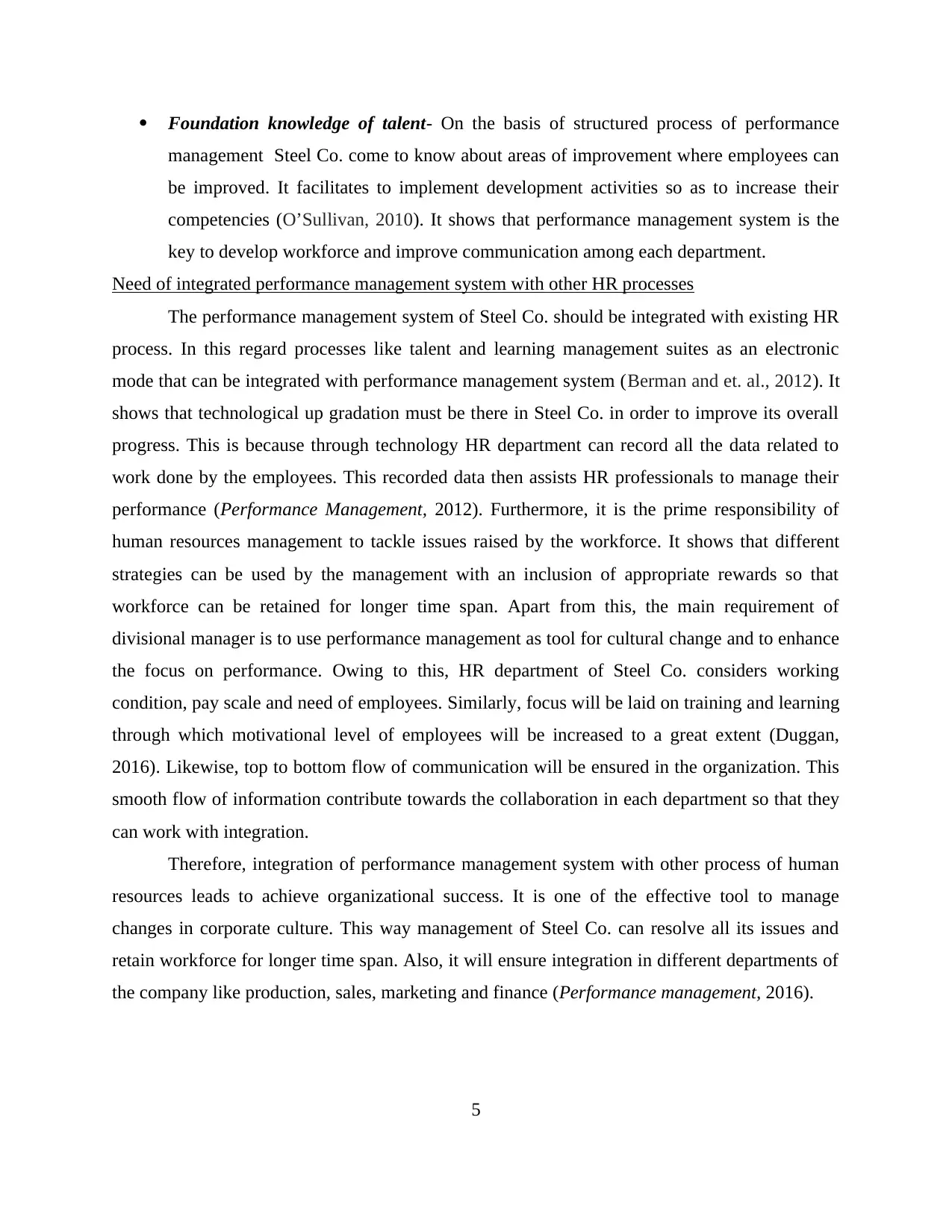
Foundation knowledge of talent- On the basis of structured process of performance
management Steel Co. come to know about areas of improvement where employees can
be improved. It facilitates to implement development activities so as to increase their
competencies (O’Sullivan, 2010). It shows that performance management system is the
key to develop workforce and improve communication among each department.
Need of integrated performance management system with other HR processes
The performance management system of Steel Co. should be integrated with existing HR
process. In this regard processes like talent and learning management suites as an electronic
mode that can be integrated with performance management system (Berman and et. al., 2012). It
shows that technological up gradation must be there in Steel Co. in order to improve its overall
progress. This is because through technology HR department can record all the data related to
work done by the employees. This recorded data then assists HR professionals to manage their
performance (Performance Management, 2012). Furthermore, it is the prime responsibility of
human resources management to tackle issues raised by the workforce. It shows that different
strategies can be used by the management with an inclusion of appropriate rewards so that
workforce can be retained for longer time span. Apart from this, the main requirement of
divisional manager is to use performance management as tool for cultural change and to enhance
the focus on performance. Owing to this, HR department of Steel Co. considers working
condition, pay scale and need of employees. Similarly, focus will be laid on training and learning
through which motivational level of employees will be increased to a great extent (Duggan,
2016). Likewise, top to bottom flow of communication will be ensured in the organization. This
smooth flow of information contribute towards the collaboration in each department so that they
can work with integration.
Therefore, integration of performance management system with other process of human
resources leads to achieve organizational success. It is one of the effective tool to manage
changes in corporate culture. This way management of Steel Co. can resolve all its issues and
retain workforce for longer time span. Also, it will ensure integration in different departments of
the company like production, sales, marketing and finance (Performance management, 2016).
5
management Steel Co. come to know about areas of improvement where employees can
be improved. It facilitates to implement development activities so as to increase their
competencies (O’Sullivan, 2010). It shows that performance management system is the
key to develop workforce and improve communication among each department.
Need of integrated performance management system with other HR processes
The performance management system of Steel Co. should be integrated with existing HR
process. In this regard processes like talent and learning management suites as an electronic
mode that can be integrated with performance management system (Berman and et. al., 2012). It
shows that technological up gradation must be there in Steel Co. in order to improve its overall
progress. This is because through technology HR department can record all the data related to
work done by the employees. This recorded data then assists HR professionals to manage their
performance (Performance Management, 2012). Furthermore, it is the prime responsibility of
human resources management to tackle issues raised by the workforce. It shows that different
strategies can be used by the management with an inclusion of appropriate rewards so that
workforce can be retained for longer time span. Apart from this, the main requirement of
divisional manager is to use performance management as tool for cultural change and to enhance
the focus on performance. Owing to this, HR department of Steel Co. considers working
condition, pay scale and need of employees. Similarly, focus will be laid on training and learning
through which motivational level of employees will be increased to a great extent (Duggan,
2016). Likewise, top to bottom flow of communication will be ensured in the organization. This
smooth flow of information contribute towards the collaboration in each department so that they
can work with integration.
Therefore, integration of performance management system with other process of human
resources leads to achieve organizational success. It is one of the effective tool to manage
changes in corporate culture. This way management of Steel Co. can resolve all its issues and
retain workforce for longer time span. Also, it will ensure integration in different departments of
the company like production, sales, marketing and finance (Performance management, 2016).
5
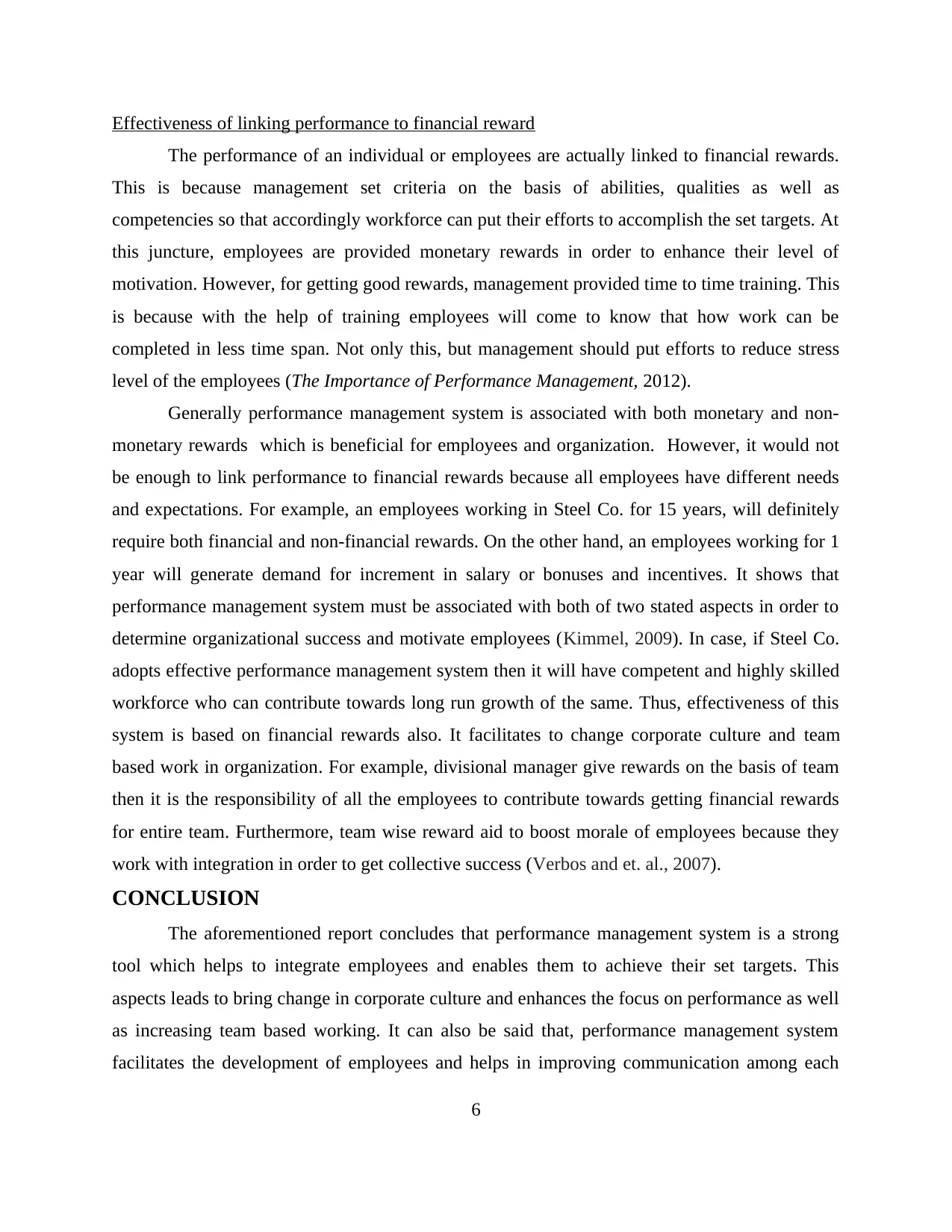
Effectiveness of linking performance to financial reward
The performance of an individual or employees are actually linked to financial rewards.
This is because management set criteria on the basis of abilities, qualities as well as
competencies so that accordingly workforce can put their efforts to accomplish the set targets. At
this juncture, employees are provided monetary rewards in order to enhance their level of
motivation. However, for getting good rewards, management provided time to time training. This
is because with the help of training employees will come to know that how work can be
completed in less time span. Not only this, but management should put efforts to reduce stress
level of the employees (The Importance of Performance Management, 2012).
Generally performance management system is associated with both monetary and non-
monetary rewards which is beneficial for employees and organization. However, it would not
be enough to link performance to financial rewards because all employees have different needs
and expectations. For example, an employees working in Steel Co. for 15 years, will definitely
require both financial and non-financial rewards. On the other hand, an employees working for 1
year will generate demand for increment in salary or bonuses and incentives. It shows that
performance management system must be associated with both of two stated aspects in order to
determine organizational success and motivate employees (Kimmel, 2009). In case, if Steel Co.
adopts effective performance management system then it will have competent and highly skilled
workforce who can contribute towards long run growth of the same. Thus, effectiveness of this
system is based on financial rewards also. It facilitates to change corporate culture and team
based work in organization. For example, divisional manager give rewards on the basis of team
then it is the responsibility of all the employees to contribute towards getting financial rewards
for entire team. Furthermore, team wise reward aid to boost morale of employees because they
work with integration in order to get collective success (Verbos and et. al., 2007).
CONCLUSION
The aforementioned report concludes that performance management system is a strong
tool which helps to integrate employees and enables them to achieve their set targets. This
aspects leads to bring change in corporate culture and enhances the focus on performance as well
as increasing team based working. It can also be said that, performance management system
facilitates the development of employees and helps in improving communication among each
6
The performance of an individual or employees are actually linked to financial rewards.
This is because management set criteria on the basis of abilities, qualities as well as
competencies so that accordingly workforce can put their efforts to accomplish the set targets. At
this juncture, employees are provided monetary rewards in order to enhance their level of
motivation. However, for getting good rewards, management provided time to time training. This
is because with the help of training employees will come to know that how work can be
completed in less time span. Not only this, but management should put efforts to reduce stress
level of the employees (The Importance of Performance Management, 2012).
Generally performance management system is associated with both monetary and non-
monetary rewards which is beneficial for employees and organization. However, it would not
be enough to link performance to financial rewards because all employees have different needs
and expectations. For example, an employees working in Steel Co. for 15 years, will definitely
require both financial and non-financial rewards. On the other hand, an employees working for 1
year will generate demand for increment in salary or bonuses and incentives. It shows that
performance management system must be associated with both of two stated aspects in order to
determine organizational success and motivate employees (Kimmel, 2009). In case, if Steel Co.
adopts effective performance management system then it will have competent and highly skilled
workforce who can contribute towards long run growth of the same. Thus, effectiveness of this
system is based on financial rewards also. It facilitates to change corporate culture and team
based work in organization. For example, divisional manager give rewards on the basis of team
then it is the responsibility of all the employees to contribute towards getting financial rewards
for entire team. Furthermore, team wise reward aid to boost morale of employees because they
work with integration in order to get collective success (Verbos and et. al., 2007).
CONCLUSION
The aforementioned report concludes that performance management system is a strong
tool which helps to integrate employees and enables them to achieve their set targets. This
aspects leads to bring change in corporate culture and enhances the focus on performance as well
as increasing team based working. It can also be said that, performance management system
facilitates the development of employees and helps in improving communication among each
6
⊘ This is a preview!⊘
Do you want full access?
Subscribe today to unlock all pages.

Trusted by 1+ million students worldwide
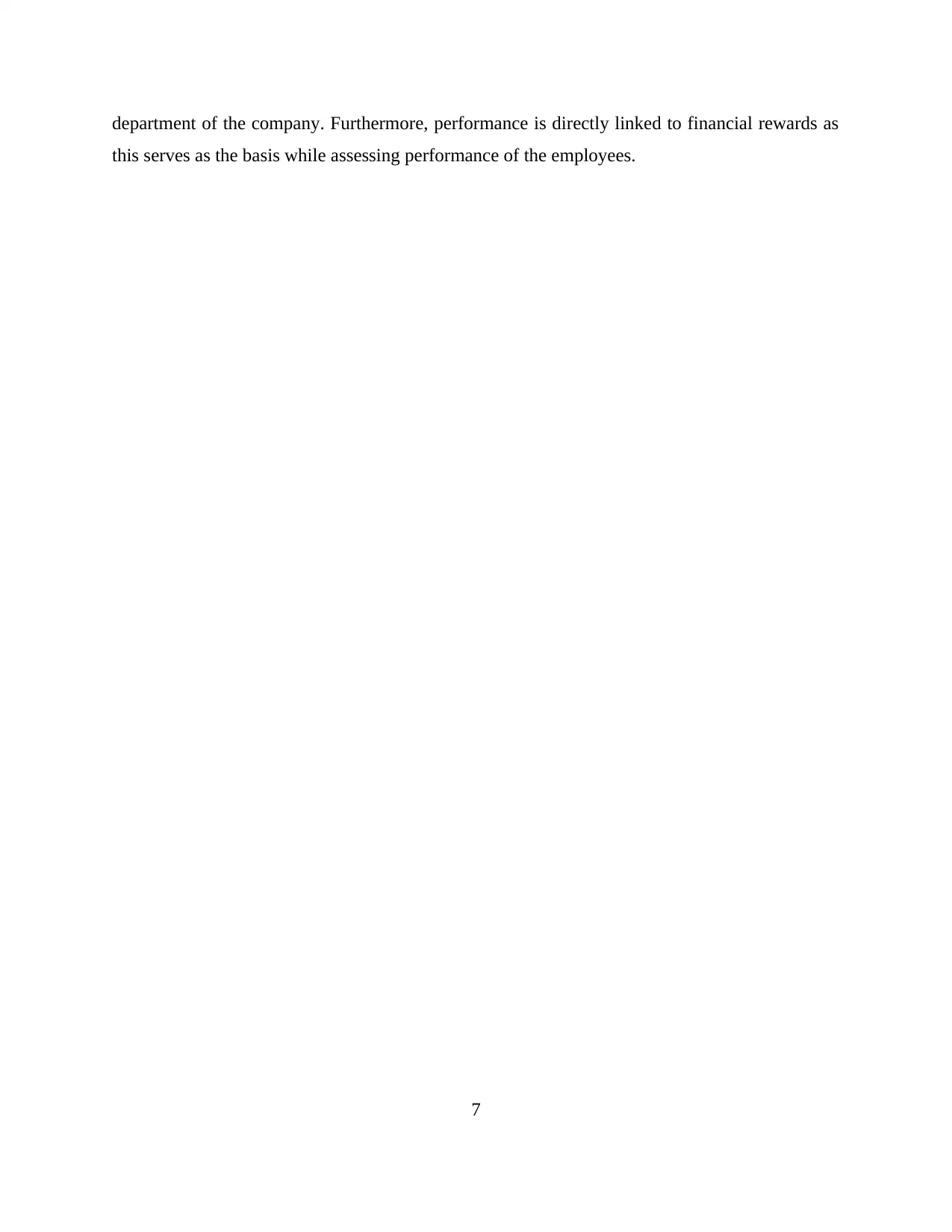
department of the company. Furthermore, performance is directly linked to financial rewards as
this serves as the basis while assessing performance of the employees.
7
this serves as the basis while assessing performance of the employees.
7
Paraphrase This Document
Need a fresh take? Get an instant paraphrase of this document with our AI Paraphraser
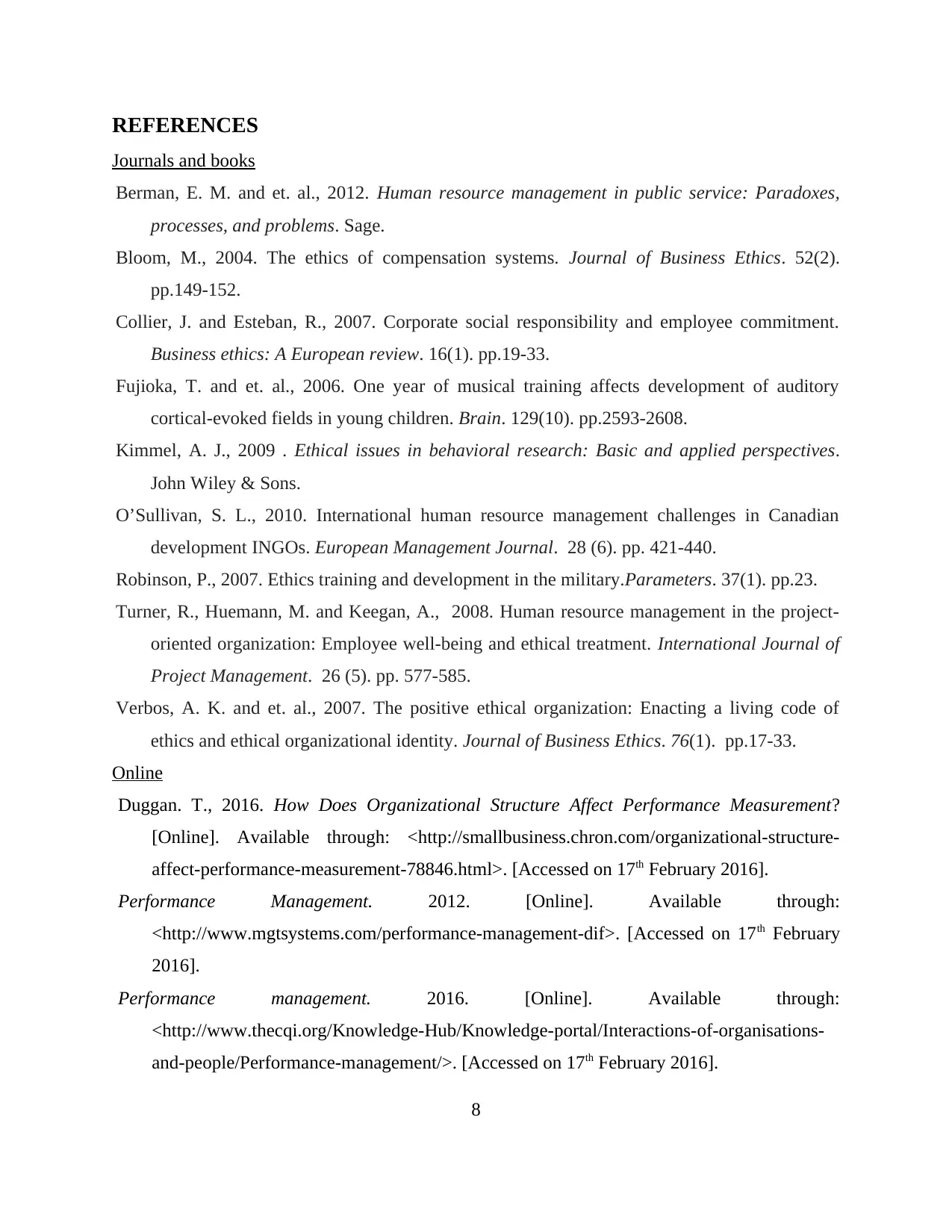
REFERENCES
Journals and books
Berman, E. M. and et. al., 2012. Human resource management in public service: Paradoxes,
processes, and problems. Sage.
Bloom, M., 2004. The ethics of compensation systems. Journal of Business Ethics. 52(2).
pp.149-152.
Collier, J. and Esteban, R., 2007. Corporate social responsibility and employee commitment.
Business ethics: A European review. 16(1). pp.19-33.
Fujioka, T. and et. al., 2006. One year of musical training affects development of auditory
cortical-evoked fields in young children. Brain. 129(10). pp.2593-2608.
Kimmel, A. J., 2009 . Ethical issues in behavioral research: Basic and applied perspectives.
John Wiley & Sons.
O’Sullivan, S. L., 2010. International human resource management challenges in Canadian
development INGOs. European Management Journal. 28 (6). pp. 421-440.
Robinson, P., 2007. Ethics training and development in the military.Parameters. 37(1). pp.23.
Turner, R., Huemann, M. and Keegan, A., 2008. Human resource management in the project-
oriented organization: Employee well-being and ethical treatment. International Journal of
Project Management. 26 (5). pp. 577-585.
Verbos, A. K. and et. al., 2007. The positive ethical organization: Enacting a living code of
ethics and ethical organizational identity. Journal of Business Ethics. 76(1). pp.17-33.
Online
Duggan. T., 2016. How Does Organizational Structure Affect Performance Measurement?
[Online]. Available through: <http://smallbusiness.chron.com/organizational-structure-
affect-performance-measurement-78846.html>. [Accessed on 17th February 2016].
Performance Management. 2012. [Online]. Available through:
<http://www.mgtsystems.com/performance-management-dif>. [Accessed on 17th February
2016].
Performance management. 2016. [Online]. Available through:
<http://www.thecqi.org/Knowledge-Hub/Knowledge-portal/Interactions-of-organisations-
and-people/Performance-management/>. [Accessed on 17th February 2016].
8
Journals and books
Berman, E. M. and et. al., 2012. Human resource management in public service: Paradoxes,
processes, and problems. Sage.
Bloom, M., 2004. The ethics of compensation systems. Journal of Business Ethics. 52(2).
pp.149-152.
Collier, J. and Esteban, R., 2007. Corporate social responsibility and employee commitment.
Business ethics: A European review. 16(1). pp.19-33.
Fujioka, T. and et. al., 2006. One year of musical training affects development of auditory
cortical-evoked fields in young children. Brain. 129(10). pp.2593-2608.
Kimmel, A. J., 2009 . Ethical issues in behavioral research: Basic and applied perspectives.
John Wiley & Sons.
O’Sullivan, S. L., 2010. International human resource management challenges in Canadian
development INGOs. European Management Journal. 28 (6). pp. 421-440.
Robinson, P., 2007. Ethics training and development in the military.Parameters. 37(1). pp.23.
Turner, R., Huemann, M. and Keegan, A., 2008. Human resource management in the project-
oriented organization: Employee well-being and ethical treatment. International Journal of
Project Management. 26 (5). pp. 577-585.
Verbos, A. K. and et. al., 2007. The positive ethical organization: Enacting a living code of
ethics and ethical organizational identity. Journal of Business Ethics. 76(1). pp.17-33.
Online
Duggan. T., 2016. How Does Organizational Structure Affect Performance Measurement?
[Online]. Available through: <http://smallbusiness.chron.com/organizational-structure-
affect-performance-measurement-78846.html>. [Accessed on 17th February 2016].
Performance Management. 2012. [Online]. Available through:
<http://www.mgtsystems.com/performance-management-dif>. [Accessed on 17th February
2016].
Performance management. 2016. [Online]. Available through:
<http://www.thecqi.org/Knowledge-Hub/Knowledge-portal/Interactions-of-organisations-
and-people/Performance-management/>. [Accessed on 17th February 2016].
8
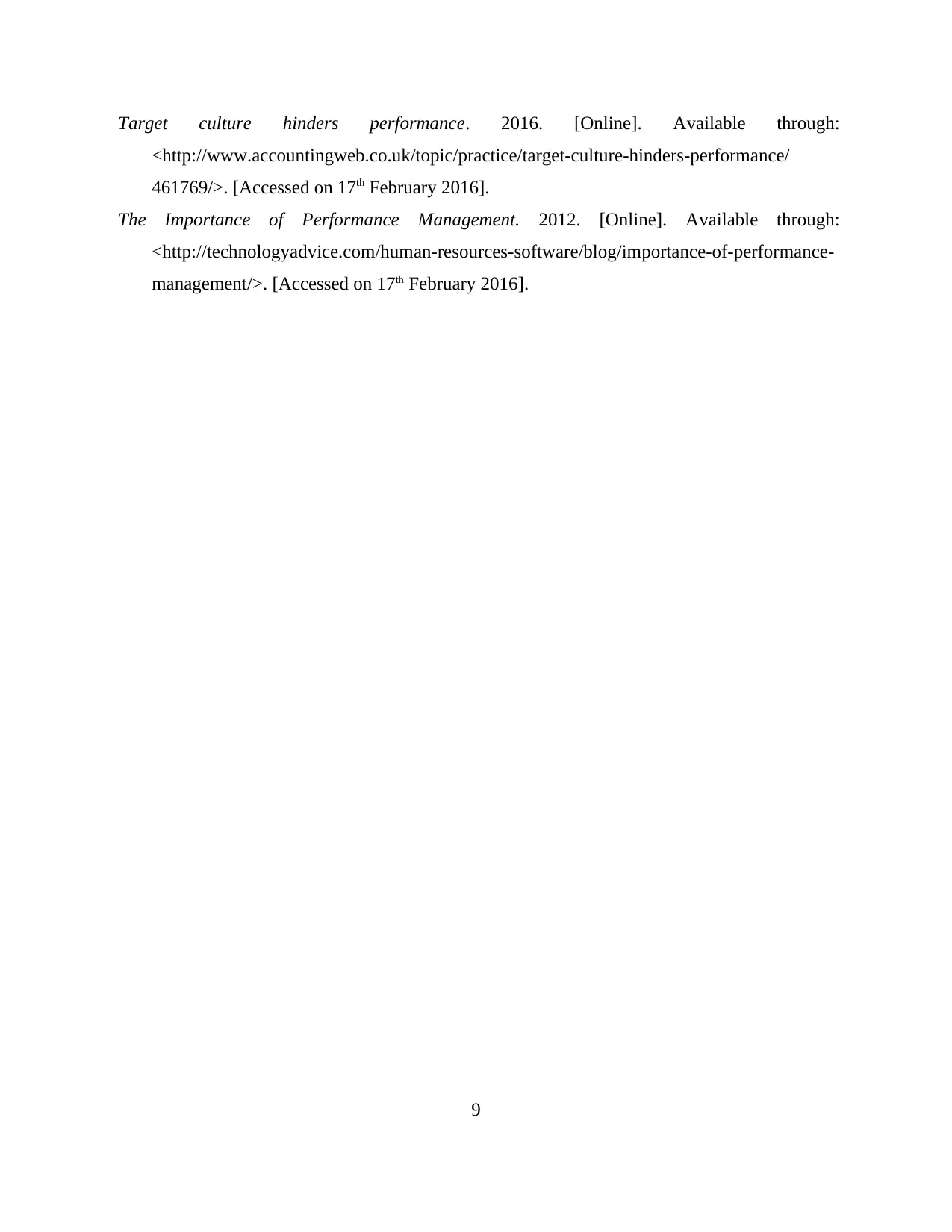
Target culture hinders performance. 2016. [Online]. Available through:
<http://www.accountingweb.co.uk/topic/practice/target-culture-hinders-performance/
461769/>. [Accessed on 17th February 2016].
The Importance of Performance Management. 2012. [Online]. Available through:
<http://technologyadvice.com/human-resources-software/blog/importance-of-performance-
management/>. [Accessed on 17th February 2016].
9
<http://www.accountingweb.co.uk/topic/practice/target-culture-hinders-performance/
461769/>. [Accessed on 17th February 2016].
The Importance of Performance Management. 2012. [Online]. Available through:
<http://technologyadvice.com/human-resources-software/blog/importance-of-performance-
management/>. [Accessed on 17th February 2016].
9
⊘ This is a preview!⊘
Do you want full access?
Subscribe today to unlock all pages.

Trusted by 1+ million students worldwide
1 out of 9
Related Documents
Your All-in-One AI-Powered Toolkit for Academic Success.
+13062052269
info@desklib.com
Available 24*7 on WhatsApp / Email
![[object Object]](/_next/static/media/star-bottom.7253800d.svg)
Unlock your academic potential
Copyright © 2020–2025 A2Z Services. All Rights Reserved. Developed and managed by ZUCOL.





